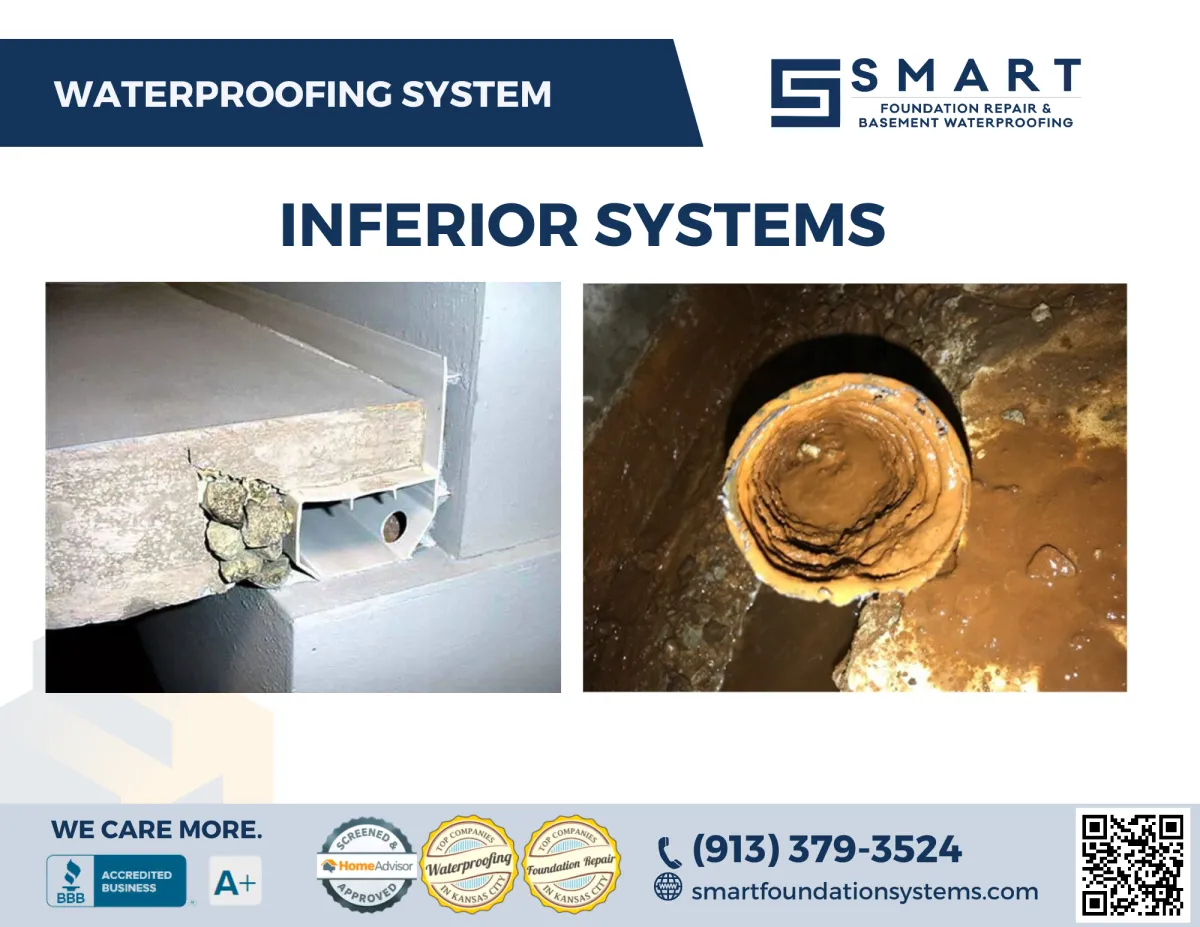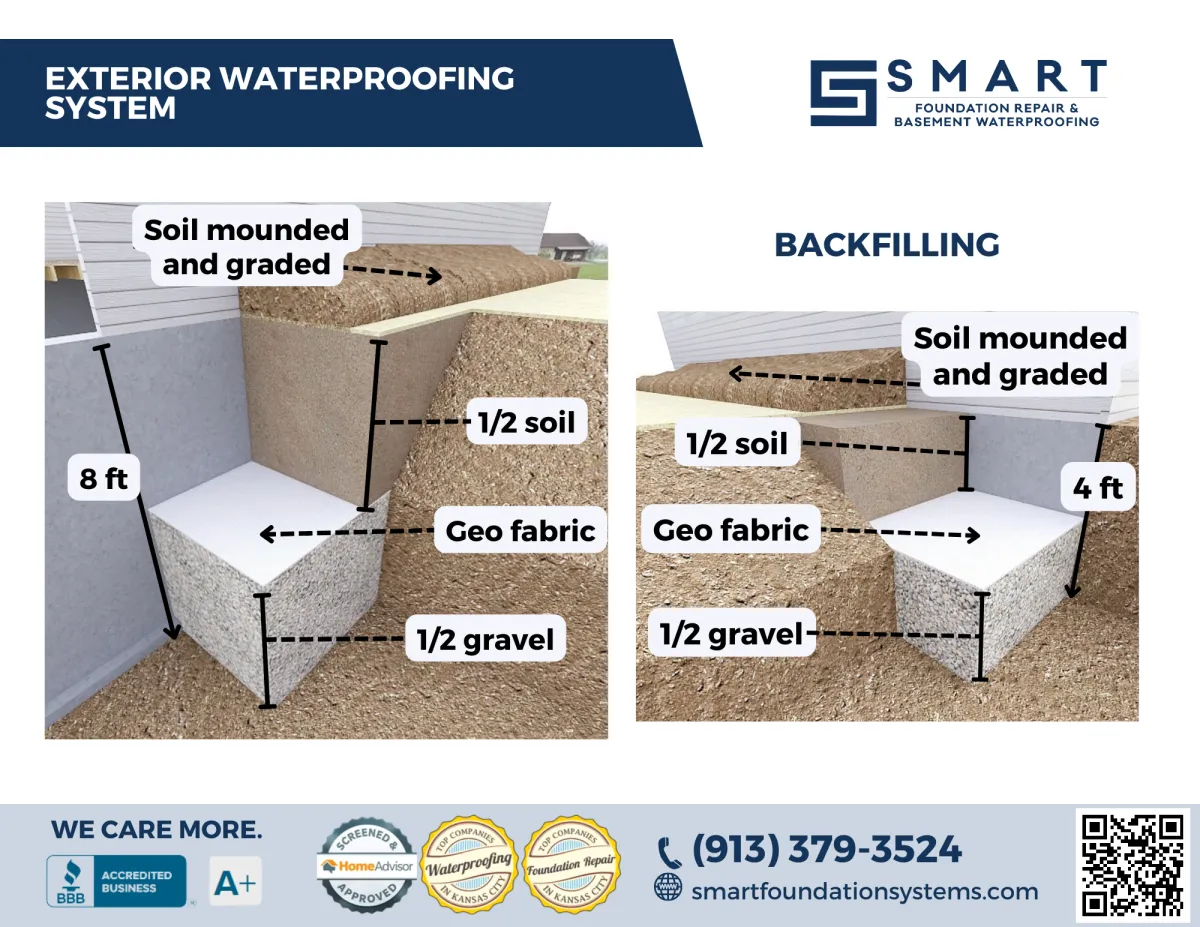Call or Text
Call or Text
Comprehensive Basement Waterproofing in Kansas City
Protect your home from water damage with our professional basement waterproofing in Kansas City. It helps prevent costly repairs, mold growth, and structural damage, ensuring your property remains safe and well-maintained.
10 Questions on Basement Waterproofing
What is the difference between interior and exterior basement waterproofing?
Which type of basement waterproofing is more effective?
How much does interior basement waterproofing cost?
How much does exterior basement waterproofing cost?
Can interior basement waterproofing be done without
excavation?
Can exterior basement waterproofing be done without
excavation?
How long does interior basement waterproofing take to
complete?
How long does exterior basement waterproofing take to complete?
What kind of warranty comes with basement waterproofing services?
How often should basement waterproofing be done?

1. What is the difference between interior and exterior basement waterproofing?
Interior and exterior basement waterproofing are two different methods used to protect homes from water damage.
Interior basement waterproofing involves installing a drainage system and sump pump inside the basement to prevent water from entering the home. This method is typically less expensive than exterior waterproofing and is often preferred when exterior excavation is not possible or desirable. Interior waterproofing is especially effective in waterproofing a basement that is experiencing settlement in addition to bowing walls.
Exterior basement waterproofing involves excavating around the foundation of the home and installing a waterproof membrane to prevent water from entering the basement. This method is more expensive than interior waterproofing, but it is also more effective in reducing hydrostatic pressure on the out side walls. Exterior waterproofing is typically the preferred method when the source of the water is outside the home, such as heavy rainfall or groundwater. Additionally, it offers the advantage of guarding against damage from water infiltration to the home's foundation.
2. Which type of basement waterproofing is more effective?
When it comes to choosing between interior and exterior basement waterproofing, effectiveness is a key consideration. While both methods can help protect homes from water damage, exterior waterproofing is generally considered to be more effective when you have wall bowing only, but interior waterproofing is better when your home has been experiencing settlement that has caused water to enter the basement.
Exterior basement waterproofing involves excavating around the foundation of the home and installing a waterproof membrane to prevent water from entering the basement. This method is more expensive than interior waterproofing, but it is very effective in reducing hydrostatic pressure on the exterior of the walls. Exterior waterproofing offers a more comprehensive solution to surface water-related basement water problems by addressing the source of the water.
Interior basement waterproofing, on the other hand, involves installing a drainage system and sump pump inside the basement to prevent water from entering the home. This method is especially useful if you are experiencing ground water entering the basement and/or your home or business is experiencing settlement. Because you seal the walls completely from the inside of the basement, any new cracks that may form due to foundation shifting, they will all be contained in the system.
In summary, both interior and exterior basement waterproofing can be effective in protecting homes from water damage. However, the decision to choose one method over the other depends on a variety of factors, including the source of the water, the cost of each method, and the homeowner's preferences and priorities.

3. How much does interior basement waterproofing cost?
The cost of interior basement waterproofing can vary depending on factors such as the size of the basement and the severity of the water problem. On average, homeowners can expect to pay between $5,000 and $20,000 for interior basement waterproofing.
This cost estimate includes the installation of a drainage system and sump pump inside the basement to prevent water from entering the home. The actual cost may be higher or lower depending on the specific needs of the homeowner. For example, if the basement is particularly large or has complex features that make installation more difficult, the cost may be higher. Conversely, if the water problem is less severe and requires a simpler solution, the cost may be lower.
It is important to note that while interior basement waterproofing is typically less expensive than exterior waterproofing, it may not be as effective at preventing future water damage. Homeowners should carefully consider the severity of their water problem and their long-term goals before deciding on a waterproofing solution. A professional waterproofing contractor can provide a personalized cost estimate and guidance on the best approach for each individual situation.

4. How much does exterior basement waterproofing cost?
The cost of exterior basement waterproofing can vary depending on the size of the home, the severity of the water problem, and the specific needs of the homeowner. On average, homeowners can expect to pay between $8,000 and $40,000 for exterior basement waterproofing.
This cost estimate includes excavating around the foundation of the home, installing a waterproof membrane, and backfilling with gravel and soil. The actual cost may be higher or lower, depending on the specific needs of the homeowner. For example, if the home has a particularly large or complex foundation, the cost may be higher. Conversely, if the water problem is less severe and requires a simpler solution, the cost may be lower.
It is important to note that while exterior basement waterproofing is generally more expensive than interior waterproofing, it is also more effective in reducing hydrostatic pressure on the foundation. Homeowners should carefully consider the severity of their water problem and their long-term goals before deciding on a waterproofing solution. A professional waterproofing contractor can provide a personalized cost estimate and guidance on the best approach for each individual situation.
5. Can interior basement waterproofing be done without excavation?
In most cases, interior basement waterproofing will require some excavation and breaking of the perimeter concrete. This is because the drainage system and sump pump need to be installed underneath the basement floor, which typically requires digging down to the foundation.
Methods known as surface sealing are NOT effective methods of waterproofing and will fail over time. This involves applying a waterproof coating to the interior walls of the basement to prevent water from seeping through. While this method can be effective in managing minor "sweating" problems, it is not recommended for more common cases. Additionally, this method does not address the source of the water and will not be as effective in preventing future water damage as more comprehensive solutions.
Another option is to install a baseboard drainage system. This involves cutting a channel into the perimeter of the basement floor and installing a drainage pipe and sump pump. While this method does not require excavation of the entire basement floor, it does require some breaking of the perimeter concrete. Additionally, baseboard systems are NOT effective as full interior drainage systems in managing water problems.
In summary, effective interior basement waterproofing will require some excavation and breaking of the perimeter concrete to install a drainage system and sump pump.
6. Can exterior basement waterproofing be done without
excavation?
Exterior basement waterproofing involves excavating around the foundation of the home and installing a waterproof membrane to prevent water from entering the basement. This method is more expensive than interior waterproofing, but it is also more effective in preventing water from entering the home in the first place. By addressing the hydrostatic pressure on the outside of the wall, exterior waterproofing provides a comprehensive solution to basement water problems. It also helps to protect the foundation of the home from damage caused by water infiltration.
Exterior basement waterproofing will require extensive excavation around the foundation of the home. This is because the waterproof membrane needs to be installed directly onto the foundation walls, which typically requires digging out the soil around the home.
One way that exterior waterproofing can reduce hydrostatic pressure is by replacing 50 - 75% of the soil backfill around the foundation with gravel. This allows water to drain away from the foundation more easily, reducing the amount of pressure on the waterproof membrane. The remaining soil backfill is then compacted around the gravel to provide additional support and stability. This method helps to ensure that the waterproofing membrane remains intact and effective in preventing water from entering the basement.
7. How long does interior basement waterproofing take to complete?
The length of time it takes to complete interior basement waterproofing will depend on a variety of factors, including the size of the basement, the severity of the water problem, and the specific waterproofing method being used.
On average, homeowners can expect interior basement waterproofing to take between one and three days. This time frame includes the installation of a drainage system and sump pump, as well as any necessary excavation and breaking of the perimeter concrete. However, the actual time required may be shorter or longer depending on the specific needs of the homeowner.
It is important to note that while interior basement waterproofing can be completed relatively quickly, it is important to allow for adequate drying time before finishing the basement. This will help ensure that the basement stays dry and free from mold and mildew growth.
A professional waterproofing contractor can provide a more detailed timeline for the completion of interior basement waterproofing based on the specific needs of the homeowner.
8. How long does exterior basement waterproofing take to complete?
The length of time it takes to complete exterior basement waterproofing will depend on a variety of factors, including the size of the home, the severity of the water problem, and the weather. On average, homeowners can expect exterior basement waterproofing to take between 3 - 7 business days to complete.
The first step in exterior waterproofing is to excavate around the foundation of the home. This can take several days, depending on the size of the home and the amount of soil that needs to be removed. Once the excavation is complete, the foundation walls are cleaned and inspected for any cracks or damage. Any cracks or defects are repaired at this time.
Next, a waterproof membrane is installed on the foundation walls. This process typically takes a day to complete, as the membrane needs to be applied thickly to ensure proper coverage. Once the membrane is in place, a drainage system is installed around the perimeter of the home. This involves laying down a layer of gravel and installing a drainage channel that leads to a sump pump.
Finally, the gravel is backfilled 50 - 75% of the wall height. The remaining amount is then filled with the soil that was removed during the process. The entire process typically takes between 3 -7 business days to complete, depending on the specific needs of the homeowner and the complexity of the project.
It is important to note that while exterior basement waterproofing can be a lengthy process, it is also a comprehensive solution to basement water problems. By addressing the hydrostatic pressure and the surface water, exterior waterproofing helps to prevent future water damage and protect the foundation of the home from structural damage. A professional waterproofing contractor can provide a more detailed timeline for the completion of exterior basement waterproofing based on the specific needs of the homeowner.
9. What kind of warranty comes with basement waterproofing services?
The type of warranty that comes with basement waterproofing services can vary depending on the contractor and the specific waterproofing method being used. It is important for homeowners to carefully review their warranty options and understand the terms and conditions before agreeing to any basement waterproofing services.
In general, most waterproofing contractors will offer a warranty on their workmanship and materials. This warranty may cover defects or problems that arise as a result of the installation process, such as leaks, cracks, or other issues. The length of the warranty can vary, but it is typically between one and ten years.
Our warranty on both our waterproofing systems are backed by limited lifetime warranties, so you can rest assured your foundation will be dry and safe for the life of the structure. Sump pump's break down over the years, but we also offer maintenance plans to ensure that your pump is checked each year.
It is important for homeowners to carefully review the terms and conditions of any warranty before agreeing to basement waterproofing services. They should also make sure to work with a reputable contractor who has a proven track record of success in basement waterproofing. By taking these steps, homeowners can ensure that they are protected against water damage and have peace of mind knowing that their basement is fully waterproofed.
In summary, the type of warranty that comes with basement waterproofing services can vary depending on the contractor and the specific waterproofing method being used. Most contractors will offer a warranty on their workmanship and materials, while some may also offer a warranty on the effectiveness of the waterproofing solution. Homeowners should carefully review their warranty options and work with a reputable contractor to ensure that they are fully protected against water damage.
10. How often should basement waterproofing be done?
The frequency at which basement waterproofing should be done largely depends on the specific needs of the homeowner and the condition of their home's foundation. In general, it is recommended that homeowners have their basements inspected by a professional waterproofing contractor every few years to assess the condition of the foundation and identify any potential water problems.
If there are signs of water damage or moisture issues in the basement, such as mold growth or musty odors, it may be necessary to waterproof the basement immediately to prevent further damage. Similarly, if the home is located in an area with high groundwater levels or is prone to heavy rainfall, it may be necessary to waterproof the basement more frequently to prevent water damage.
In addition to regular inspections, homeowners can take steps to prevent water damage and prolong the lifespan of their waterproofing system. This includes keeping gutters and downspouts clean and in good repair, grading the soil around the home to ensure that water flows away from the foundation, and avoiding planting trees or shrubs near the foundation, as their roots can damage the waterproofing membrane.
Overall, the frequency at which basement waterproofing should be done depends on a variety of factors, including the condition of the foundation, the severity of the water problem, and the homeowner's long-term goals. A professional waterproofing contractor can provide personalized guidance on the best approach for each individual situation.
Put your trust in the best foundation repair company in Kansas City for unmatched service and results.
Contact us today by phone, text, or here!
Foundation issues?
Request a free inspection today.
I agree to terms & conditions By providing my phone number, I agree to receive text messages from Smart Foundation Repair.

Business Information
Smart Foundation Repair and Basement Waterproofing Kansas City
5520 Raytown Rd, Raytown, MO 64133
(816) 666-8415
Copyright © Smart Foundation Repair and Basement Waterproofing - 2024



